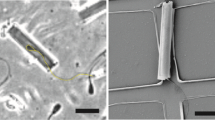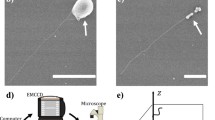Abstract
Cell membrane potential affects the electrostatic self-assembly of magnetizable nanoparticles around the flagellum of sperm cells, leading to the formation of biohybrid microrobots (i.e., IRONSperm) with various bending stiffness. Here we explain the influence of bull sperm cell membrane potential on the formation of two types of IRONSperm samples that are produced by electrostatic self-assembly. The first type is a proximal-coated soft body with nanoparticles concentrated on the head to maintain high flexibility of the flagellum and create a passively propagating transverse bending wave under the influence of an external rotating magnetic field. The second type is a rigid-body with nanoparticles approximately uniformly distributed along the length to provide arbitrary geometry that maintains a constant chiral shape and propel by rotation about its long axis. We present a magneto-elastohydrodynamic model to predict the swimming speed at low Reynolds number for rigid IRONSperm with arbitrary shapes, and show that decreasing the bending stiffness allows the model to capture the behavior of its soft counterpart. While the response of a rigid chiral IRONSperm is distinguished by a greater swimming speed with a smooth decay with frequency, the benefit of a soft flagellum in certain scenarios would present a much smaller range of frequencies for wireless actuation.







Similar content being viewed by others
Availability of data and materials
Additional data are available upon request from the authors.
References
Nelson BJ, Kaliakatsos IK, Abbott JJ (2010) Microrobots for minimally invasive medicine. Annu Rev Biomed Eng 12:55–85
Sitti M, Ceylan H, Hu W, Giltinan J, Turan M, Yim S, Diller E (2015) Biomedical applications of untethered mobile milli/microrobots. Proc IEEE Inst Electr Electron Eng 103:205–224
Zhang L, Petit T, Lu Y, Kratochvil BE, Peyer KE, Pei R, Lou J, Nelson BJ (2010) Controlled propulsion and cargo transport of rotating nickel nanowires near a patterned solid surface. ACS Nano 4:6228–6234
Kummer MP, Abbott JJ, Kratochvil BE, Borer R, Sengul A, Nelson BJ (2010) OctoMag: an electromagnetic system for 5-DOF wireless micromanipulation. IEEE Trans Robot 26:1006–1017
Behkam B, Sitti M (2007) Bacterial flagella-based propulsion and on/off motion control of microscale objects. Appl Phys Lett 90:023902
Magdanz V, Gebauer J, Mahdi D, Simmchen J, Khalil ISM (2019) In: International conference on manipulation, automation and robotics at small scales (MARSS). pp. 1–6
Reid AT, Redgrove K, Aitken RJ, Nixon B (2011) Cellular mechanisms regulating sperm-zona pellucida interaction. Asian J Androl 13:88–96
Huang X, Jain PK, El-Sayed IH, El-Sayed MA (2008) Plasmonic photothermal therapy (PPTT) using gold nanoparticles. Lasers Med Sci 23:217–28
Yan X, Zhou Q, Vincent M, Deng Y, Yu J, Xu J, Xu T, Tang T, Bian L, Wang Y-XJ, Kostarelos K, Zhang L (2017) Multifunctional biohybrid magnetite microrobots for imaging-guided therapy. Sci Robot 2:eaaq1155
Na HB, Song IC, Hyeon T (2009) Inorganic nanoparticles for MRI contrast agents. Adv Mat 21:2133–2148
Dias JMS, Estima D, Punte H, Klingner A, Marques L, Magdanz V, Khalil ISM (2022) Modeling and characterization of the passive bending stiffness of nanoparticle-coated sperm cells using magnetic excitation. Adv The Sim 5:2100438
Magdanz V, Vivaldi J, Mohanty S, Klingner A, Vendittelli M, Simmchen J, Misra S, Khalil ISM (2021) Impact of segmented magnetization on the flagellar propulsion of sperm-templated microrobots. Adv Sci 8:2004037
Teves ME, Roldan ERS (2021) Sperm bauplan and function and underlying processes of sperm formation and selection. Physiol Rev 102(1):7–60
Gao W, Feng X, Pei A, Kane CR, Tam R, Hennessy C, Wang J (2014) Bioinspired helical microswimmers based on vascular plants. Nano Lett 14:305–310
Kamata K, Piao Z, Suzuki S, Fujimori T, Tajiri W, Nagai K, Iyoda T, Yamada A, Hayakawa T, Ishiwara M, Horaguchi S, Belay A, Tanaka T, Takano K, Hangyo M (2015) Spirulina-templated metal microcoils with controlled helical structures for THz electromagnetic responses. Sci Rep 4:4919
Gilbert D, Ehrenstein G (1984) Membrane surface charge. Squid Axon 22:407–421
Klausen LH, Fuhs T, Dong M (2016) Mapping surface charge density of lipid bilayers by quantitative surface conductivity microscopy. Nat Commun 7:12447
Brennen C, Winnet H (1977) Fluid mechanics of propulsion by cilia and flagella. Ann Rev Fluid Mech 9:339–398
Magdanz V, Gebauer J, Sharan P, Eltoukhy S, Voigt D, Simmchen J (2019) Sperm-particle interactions and their prospects for charge mapping. Adv Biosys 3:1900061
Okuno M, Hiramoto Y (1979) Direct measurements of the stiffness of echinoderm sperm flagella. J Exp Biol 79:235–243
Magarkar A, Dhawan V, Kallinteri P, Viitala T, Elmowafy M, Róg T, Bunker A (2014) Cholesterol level affects surface charge of lipid membranes in saline solution. Sci Rep 4:5005
Lesich KA, de Pinho TG, Dang L, Lindemann CB (2014) Ultrastructural evidence that motility changes caused by variations in ATP, Mg2+, and ADP correlate to conformational changes in reactivated bull sperm axonemes. Cytoskeleton 71:649–661
Yu TS, Lauga E, Hosoi AE (2006) Experimental investigations of elastic tail propulsion at low Reynolds number. Phys Fluids 18:091701
Gadelha H (2013) On the optimal shape of magnetic swimmers. Regular Chaotic Dynamics 18:75–84
Friedrich BM, Riedel-Kruse IH, Howard J, Jülicher F (2010) High-precision tracking of sperm swimming fine structure provides strong test of resistive force theory. J Exp Biol 213:1226–1234
Rodenborna B, Chena C-H, Swinneya HL, Liub B, Zhang HP (2013) Propulsion of microorganisms by a helical flagellum. Proc Natl Acad Sci U S A 110:E338–E347
Magdanz V, Khalil ISM, Simmchen J, Furtado GP, Mohanty S, Gebauer J, Xu H, Klingner A, Aziz A, Medina-Sánchez M, Schmidt OG, Misra S (2020) IRONSperm: sperm-templated soft magnetic microrobots. Sci Adv 6:eaba5855
Funding
V. M. acknowledges the La Caixa Foundation (grant 100010434) for funding. This work was supported by the Faculty of Engineering Technology, University of Twente, under Grant Crazy-Research-2022.
Author information
Authors and Affiliations
Contributions
V.M. conducted the biological study on spermatozoa and magnetically functionalized sperm. AK, LA and IK created the mathematical model of IRONSperm of different bending stiffness. AK, IK and VM prepared the figures. All authors wrote and reviewed the manuscript.
Corresponding authors
Ethics declarations
Competing interests
The authors declare no competing financial or personal interests.
Additional information
Publisher's Note
Springer Nature remains neutral with regard to jurisdictional claims in published maps and institutional affiliations.
Rights and permissions
Springer Nature or its licensor (e.g. a society or other partner) holds exclusive rights to this article under a publishing agreement with the author(s) or other rightsholder(s); author self-archiving of the accepted manuscript version of this article is solely governed by the terms of such publishing agreement and applicable law.
About this article
Cite this article
Magdanz, V., Klingner, A., Abelmann, L. et al. IRONSperm swimming by rigid-body rotation versus transverse bending waves influenced by cell membrane charge. J Micro-Bio Robot 18, 49–60 (2022). https://doi.org/10.1007/s12213-023-00158-5
Received:
Revised:
Accepted:
Published:
Issue Date:
DOI: https://doi.org/10.1007/s12213-023-00158-5




